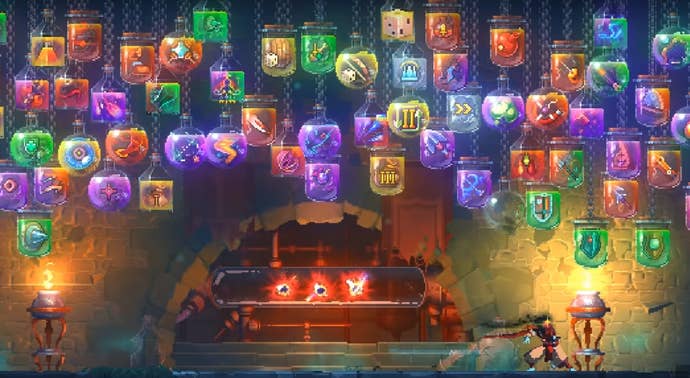Dead Cells Review
Run, dodge, and kill your way to victory.
This article first appeared on USgamer, a partner publication of VG247. Some content, such as this article, has been migrated to VG247 for posterity after USgamer's closure - but it has not been edited or further vetted by the VG247 team.
Dead Cells is a game with very little context. Sometimes, context is important. With some games, I'm there for the story. I want to know about my character's motivations or the roots of the world they inhabit. I want the game to transport me somewhere else.
But sometimes the story doesn't matter. I just want to play and get acquainted with the game's design. Dead Cells is definitely one of the latter games.

Dead Cells is a roguelite game in the Metroidvania genre, from independent developer Motion Twin. This is not a genre that leaves players without choices these days. The menu is pretty full at this point, with a number of flavors to choose from. Hollow Knight is fantastic, hand-crafted entry with wonderful atmosphere. Chasm came out last week; it's a bit long in the tooth, but it does the job. Salt and Sanctuary is on the fringes, playing more like a 2D version of the fan-favorite Dark Souls series.
Dead Cells leans closer to the Salt and Sanctuary side, focusing more on combat and platforming than anything else. You play a nameless blob possessing a series of corpses. Your only job is to make your way out of the prison you find yourself trapped in, killing everything that you run into. This is a roguelite though, so you will likely die in many of your attempts.
Each time you die, you're dropped back in starting prison cell (yup) and the path ahead is regenerated randomly. Yep, this is procedurally-generated Metroidvania action. The biomes remain in the same order each time: the first level is always the Prisoner's Quarters and completing that stage offers you the choice between to either the Toxic Sewers or the The Promenade of the Condemned. From there, it's a wandering path through the other biomes like the Ossuary, Stilt Village, or the Clock Tower.
Each biome has a specific enemy level range, enemy types, and environmental traps. Every enemy has its own rather static pattern for you to learn. You have some meager starting weapons: a basic sword and your choice between a shield or bow. When you kill foes, they drop gold and cells, the currency behind the game's title. Occasionally, they'll also drop blueprints, which allow you to unlock better weapons. You'll also find weapons, sub-weapons like grenades and traps, gold, and boost scrolls for the game's three stats—Brutality, Tactics, and Survival—during your journeys.
In-between nearly every biome, you'll run into the Collector's room, which allows you to refill your health, turn in any blueprints, spend your cells to unlock weapons, and upgrade your character. This is your bank, where you save your gains. Die and you lose everything: all your weapons, all your cells, and most of your gold.
There's hope though! At the Collector's room, you can eventually purchase upgrades to the amount of gold that carries between deaths and allow your starting weapons to be drawn from the blueprints you've unlocked. After every boss fight, you'll also get a shot at the Forge, which allows you to upgrade the drop frequency of better items. These Forge upgrades persist through death, meaning as you play Dead Cells, you are getting stronger and stronger each time. This does mean that you're unlocking better results from the random number generator, which isn't entirely satisfying.

But those are just the mechanics that underpin the play, and Dead Cells is all about the play. The controls are amazingly tight and responsive in Dead Cells, probably the best out of all the Metroidvania games I've played recently. It feels great to run, jump, dodge, and attack in each level; it's very rare that I feel the game has stolen a life from me. The combat has real weight to it, with hits from larger weapons feeling meaty and smaller weapons feeling quick and quiet. The animation is fantastic and the game runs largely at 60fps (I noticed some frame stutters and slow down in hectic situations on undocked Nintendo Switch, but nothing too bad).
I can't stress this enough: there are roguelites and Metroidvania games that do other things better, but none of them feels as good in moment-to-moment play as Dead Cells.
As you start to settle into Dead Cells, it becomes about speeding through each level. There's an fantastic sense of flow, where you never really stop moving. You're not thinking about time limits or anything, but continuous action is your ultimate focus. Dead Cells feels like a speedrun game where you're trucking through trying to collect as much as possible in the time allotted. Motion Twin seems to have designed for this as some levels have doors that only unlock within specific time limits. You'll find a door only to have it say, "This door locked 1 minute ago." Trust me, watching speedrunners tackle Dead Cells is going to be fascinating.

You'll also begin understanding the game's subtle combat mechanics. For example, falling from a great height causes no damage, but does stun your character. If you use a dive attack, that cancels out the stun entirely, but the dive attack only lasts for a short period time. So you either time the dive attack, or dodge roll mid-air to reset it. The dodge roll itself has specific timing for its invincible frames. Shields take up a slot that can be used for a weapon, but they can be used to parry, stunning enemies and negating their damage completely. Elemental interactions with the environment are important too, like moving a frozen enemy into a pool of water containing others, thus slowing them down from freezing effects.
Once you have everything down, a veteran player can probably finish a run in Dead Cells in around 30-60 minutes. It's a game that's made to be run multiple times though and it'll take you many, many hours of play to get to that point. And once you do, there are harder difficulties, more unlocks, and different strategies you can use. The Steam version of the game has support for mods and the Steam Workshop. There's also the Daily Run, a daily challenge that tasks you with finishing a different map within a time limit for a spot on the daily Leaderboard.
The only thing that feels off about Dead Cells is the unlock and upgrade system for subsequent runs. The game has been on Steam Early Access for some time and prior to the Baguette Update in May, there was a different system. The previous system had you upgrading weapons directly at the Forge; this was more satisfying, with concrete results for each upgrade, but the developer found it locked players into using a few weapons. The current Forge system feels a bit more nebulous and grindy to me. The gap between starting out and really getting somewhere in terms of progression is longer. This is different from the cells-based upgrades from the Collector and the minor forge, which still feel pretty good.
There's also an issue with stat scrolls: enemies scale with the number of scrolls collected, so after a certain point, it's better to not grab them. These are things that can be tweaked and fixed with further patches though and Motion Twin has already proven rather quick in that respect.
Dead Cells comes screaming out of its prison cell strong. Things slow down a bit as the progression system and run repetition set in, but the moment-to-moment action stays fantastic all the way through. Given how much of the game relies on the Random Number God, sometimes the difference between a good and great run is you getting just the right weapon, not how you play, but you'll just dust yourself off and try again. Overall, Dead Cells is fantastic and well worth a pickup if you're up for the challenge.

ConclusionThe field of indie roguelike Metroidvanias is littered with competition, but Dead Cells stands out by focusing on movement and combat. None of its peers feel as good in their moment-to-moment play. The controls are tight, the movement is fluid, and the combat has a real weight to it. Once you get into it, Dead Cells is about this unique state of combat flow, where you're moving, dodging, and killing your way to the end at high-speed. The progression system causes the game to stumble a little, since it's less than satisfying to upgrade a chance at better items dropping. But Dead Cells is a winner overall, especially if you're a player who's all about technique and execution.










